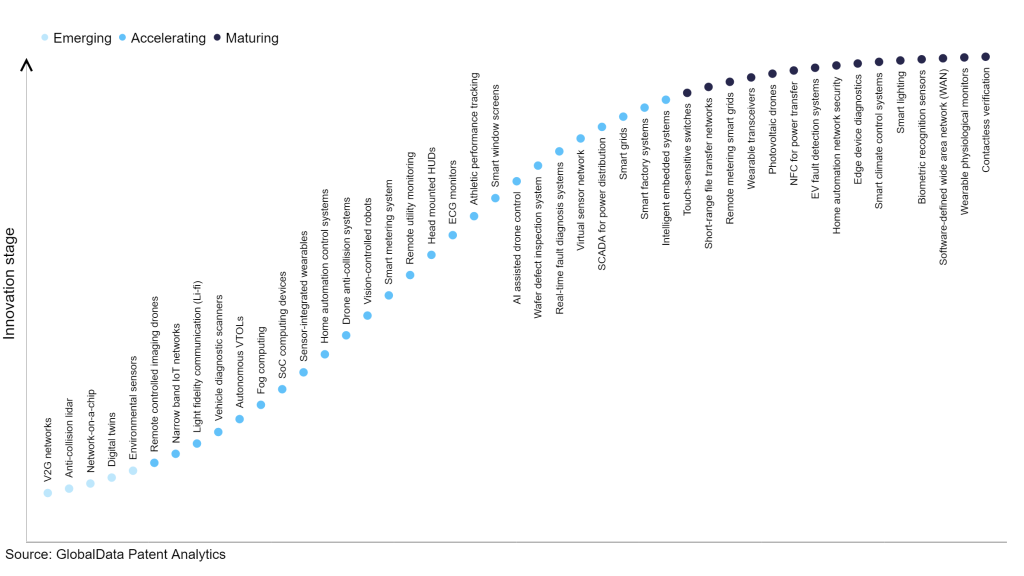The technology sector remains a hub of innovative activity, primarily fuelled by the convergence of technological progress, heightened connectivity, and the necessity for companies to enhance efficiency and competitiveness in a swiftly transforming marketplace, as well as growing importance of technologies such as microcontrollers and microprocessors, sensors and actuators, connectivity and networking, and real-time operating systems. These technologies work together to create intelligent embedded systems capable of autonomous decision-making, adaptive behaviour, and advanced functionality. In the last three years alone, there have been over 3.6 million patents filed and granted in the technology industry, according to GlobalData’s report on Innovation in Internet of Things: Intelligent embedded systems. Buy the report here.
However, not all innovations are equal and nor do they follow a constant upward trend. Instead, their evolution takes the form of an S-shaped curve that reflects their typical lifecycle from early emergence to accelerating adoption, before finally stabilising and reaching maturity.
Identifying where a particular innovation is on this journey, especially those that are in the emerging and accelerating stages, is essential for understanding their current level of adoption and the likely future trajectory and impact they will have.
300+ innovations will shape the technology industry
According to GlobalData’s Technology Foresights, which plots the S-curve for the technology industry using innovation intensity models built on over 2.5 million patents, there are 300+ innovation areas that will shape the future of the industry.
Within the emerging innovation stage, environmental sensors, digital twins, and network-on-a-chip are disruptive technologies that are in the early stages of application and should be tracked closely. Intelligent embedded systems, smart factory systems and smart grids are some of the accelerating innovation areas, where adoption has been steadily increasing. Among maturing innovation areas are, contactless verification, wearable physiological monitors, and software-defined wide area network, which are now well established in the industry.
Innovation S-curve for IoT in the technology industry

Intelligent embedded systems is a key innovation area in IoT
Intelligent embedded systems refer to computer systems integrated into physical devices or products, possessing the ability to make decisions and carry out commands through their programming or external input. These systems find application in diverse fields such as industrial automation, robotics, medical devices, and consumer electronics.
GlobalData’s analysis also uncovers the companies at the forefront of each innovation area and assesses the potential reach and impact of their patenting activity across different applications and geographies. According to GlobalData, there are 200+ companies, spanning technology vendors, established technology companies, and up-and-coming start-ups engaged in the development and application of intelligent embedded systems.
Key players in intelligent embedded systems – a disruptive innovation in the technology industry
‘Application diversity’ measures the number of different applications identified for each relevant patent and broadly splits companies into either ‘niche’ or ‘diversified’ innovators.
‘Geographic reach’ refers to the number of different countries each relevant patent is registered in and reflects the breadth of geographic application intended, ranging from ‘global’ to ‘local’.
Patent volumes related to intelligent embedded systems
Source: GlobalData Patent Analytics
Tencent is one of the leading patents filers in intelligent embedded systems. The company’s patents are aimed at face model matrix training method, apparatus, and storage medium.
The method includes obtaining a face image library comprising multiple groups of face images, separately parsing each group of the images, calculating a first matrix and a second matrix according to parsing results, and training face model matrices according to the first matrix and the second matrix.
Other prominent patent filers in the space include Samsung and Stradvision.
By geographic reach, Snap-on leads the pack, followed by Sartorius and WheelRight. In terms of application diversity, AbbVie holds the top position, followed by Grabango and UVeye.
Intelligent embedded systems have ability to transform devices, products, and industries by bringing intelligence, connectivity, automation, and advanced capabilities to the physical world. These systems enable enhanced functionality, improved efficiency, and better user experiences, while driving innovation and paving the way for a more interconnected and intelligent future.
To further understand how IoT is disrupting the technology industry, access GlobalData’s latest thematic research report on Internet of Things – Thematic Research.
Data Insights
From

The gold standard of business intelligence.
Blending expert knowledge with cutting-edge technology, GlobalData’s unrivalled proprietary data will enable you to decode what’s happening in your market. You can make better informed decisions and gain a future-proof advantage over your competitors.







